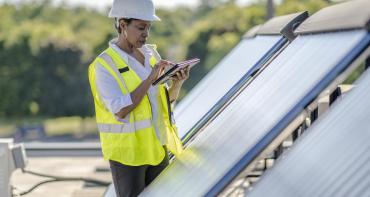By Dr Ruth Kattumuri and Brenda Wagaba
The United Nations report (United Nations, 2023) is part of the global stocktake for Sustainable Development Goals (SDGs) toward achieving these goals by 2030.

In memory of Mr. Bindeshwar Pathak who passed away on 15 August 2023.
This report indicates there has been adequate progress with SDG 6 to ‘ensure availability and sustainable management of water and sanitation for all’ but acceleration is required. Despite improvements in the delivery of the fundamental services under SDG 6, billions lack access to safe water, sanitation, and hygiene (United Nations, 2021). Further, water scarcity is becoming an increasing global concern due to climate change and conflict (United Nations, 2023). For locations with contamination continues to impact water quality (World Bank, 2023).
Commonwealth Scenario
Member countries in the Sub-Saharan African and South Asian region face significant water and sanitation challenges in the Commonwealth. Since 2015, the number of people without safely managed drinking water in Sub-Saharan Africa has increased from 703 to 766 million and 1 out of 3 people have no hand washing facility at all (United Nations, 2021). Over 494 million individuals worldwide who practise open defecation reside in these two regions. For instance, in India 91 million people (6% of the population) lack access to safe water, and 746 million people (54%) lack access to safely managed household sanitation facilities (Water.org, 2023). Diarrheal diseases, which are still the leading cause of infant mortality in Africa, are caused by open defecation (World Bank, 2019).
Availability of adequate water helps with quality sanitation practices. Yet, water stress is one of the concerns affecting countries in Africa and Asia. For instance, India, Pakistan, and Singapore experience severe water stress due to high withdrawals to satisfy population demand, lack of freshwater resources, and insufficient land for storage. A NITI Aayog report estimated that 21 cities in India would run out of groundwater affecting more than 100 million population (NITI Aayog, 2018). And yet water management is not only an issue of physical scarcity but also concerns challenges of water governance (Rout & Kattumuri, 2022). Singapore demonstrates best practises in water stress management and governance. It has enhanced water management through sustainable water usage practices. Utilising treated effluent and desalinated water, Singapore has diversified its resources. It has also made substantial investments in underground drainage systems and dams, research and development, and water conservation awareness campaigns (World Bank, 2023).
It is crucial to note that while low water stress implies sustainable usage, it may not fully indicate a country's inability to manage its water resources for the benefit of its population. In some low-income member countries, water stress is extremely low, but access is limited. In Uganda, for instance, the level of water stress is only 5.8%, but only 17% of the population has access to safely managed potable water (World Bank, 2023).
UN launched acceleration frameworks to address the slowing progress due to COVID-19 pandemic for achieving SDGs. The SDG 6 Global Acceleration Framework 2020 aimed to deliver fast results at an increased scale. Five accelerators were identified to drive action, and these included optimized financing, improved data and information, capacity development, innovation, and governance (United Nations, 2021).
Sulabh International Social Service Organisation: A Case Study
Sulabh International has pioneered innovation for sanitation reform. In line with the SDG 6 Global Acceleration Framework, their work not only contributes to innovation but also towards optimised financing and capacity development. Dr Bindeshwar Pathak founded Sulabh being inspired by Gandhi's commitment to inclusiveness and cleanliness for all, especially India's lower castes. Sulabh employs sociology and innovation to solve India's sanitation problem by combining design, financing, public will, municipal resources, and basic, inexpensive nature-based technology, such as the pour-flush Sulabh Shauchalaya - a compost latrine (Sulabh, 2022).
In India, Sulabh has enhanced urban sanitation facilities by initiating pay-to-use public lavatories. More than 9000 public lavatories have been built including in several well-known tourist destinations. These facilities have been installed in public areas such as train/bus stations, parks, and markets, thereby facilitating access to public services and ensuring proper sanitation. In turn, this has enhanced the tourism industry's image, which was previously marred by poor sanitation. Pay-to-use restrooms in public areas have ensured the toilets' durability, maintenance, and consistent hygiene, thereby improving India's sanitation. The installation of pissoirs in public places is an example of a solution to the problem of urinating in public (Pais, 2022). Because of India's clean environment, domestic and international tourism has increased, contributing to the nation's economic growth.
Connected to the public toilets, Sulabh has installed 190 biogas facilities that produce bio fertilisers and biogas from human waste. Biogas is a renewable solution for cooking, lighting, and electricity generation while the bio-fertiliser has been used to enhance agriculture and provide sustenance for low-income populations. Through consulting with scientists (such as Raja Ramanna, former Head of Indian Space Research Organisation) and innovators, Dr Pathak developed the technology to deal with faecal sludge effectively ensuring environmental sustainability (Sulabh International, 2022).

Figure 1: Biogas Digester
To provide safe water to India’s poorest communities especially those affected by arsenic contamination, Sulabh in collaboration with 1001 Fontaines, has devised a clever remedy for West Bengal's arsenic-affected areas. A process to produce potable water from surface water that is less complex, less expensive to construct and maintain, and requires fewer skill sets for operation and maintenance (Sulabh International, 2022).
As a result, the innovations from Sulabh have improved the health and well-being of communities in India progressing Gandhi’s vision of cleanliness (Rathi, 2022). The collective efforts of the organisations are geared towards achieving SDG 6 targets of 1) universal access to water, sanitation, and hygiene 2) capacity building in water and sanitation programmes, and 3) community participation. In addition, the organisation contributes to the utilisation of renewable energy (SDG 7) and the reduction of inequality by restoring the dignity of marginalised communities (SDG 10)
Lessons and best practicesSulabh International provides facilities in several countries and offers important lessons and best practices that can be shared across Commonwealth countries. There are opportunities for collaboration to identify and employ simple materials (utilise nature-based solutions) to reduce open defecation and enhance quality sanitation for urban and rural poor, thereby progressing with achieving SDG 6. Low-and middle-income countries can benefit from innovations for sanitation developed by Sulabh. There are also opportunities to learn from the organization's efforts to alter societal attitudes towards open defecation and to stimulate investment in basic and affordable sanitation technologies. Additionally, mechanisms have been devised to promote global water and sanitation programmes such as toilet twinning (Tearfund, 2022). Toilet twinning funds global water and sanitation programmes to enable construction of a new toilet for a family in a poorer country who later become advocates for sanitation change in their communities (Tearfund, 2022). There is an urgent need to expand such initiatives toward achieving SDG6.
|
Image

|
References
Cameroon, L., 2013. Impact evaluation of a large-scale rural sanitation project in Indonesia.
Coffey, D., 2014. Revealed Preference for Open Defecation.
Liu, L., 2012. Global, regional, and national causes of child mortality: an updated systematic analysis for 2010 with time trends since 2000..
Myers, R. C. a. J., 2016. Frontiers of CLTS: Innovations and Insights. 07 January.
NITI Aayog, 2018. Composite water management index, s.l.: s.n.
Pais, R., 2022. Action Sociology Contributions of Dr Bindeshwar Pathak. s.l.:Rawat Publications.
Rathi, S., 2022. Importance of Gandhian thoughts about Cleanliness. [Online]
Available at: https://www.mkgandhi.org/articles/gandhian-thoughts-about-cleanliness.html
Rout, S. & Kattumuri, R., 2022. Urban Water Supply and Governace in India. s.l.:Springer.
Rout, S. & Kattumuri, R., 2022. Urban Water Supply and Governance in India. s.l.:Springer.
Sulabh International, 2022. [Online]
Available at: https://www.sulabhinternational.org/sulabh-technologies-bio-gas/
Sulabh International, 2022. [Online]
Available at: https://www.sulabhinternational.org/sulabh-water-project/
Sulabh, 2022. [Online]
Available at: https://www.sulabhinternational.org/about-sulabh-international-social-service-organisation-new/
Talbot, M., 1896. Sanitation and Sociology.
Tearfund, 2022. Toilets, Sanitation and Training. A life-saving trio. [Online]
Available at: https://toilettwinning.org/
Twinning, T., 2022. Toilet Twinning. [Online]
Available at: https://toilettwinning.org/transparency
United Nations, 2021. Summary Progress Update 2021: SDG 6- water and sanitation for all. July.
United Nations, 2023. Progress towards the Sustainable Development Goals: Towards a rescue plan for people and planet, s.l.: s.n.
Water.org, 2023. India's water and sanitation crisis, s.l.: s.n.
WHO, 2021. Progress on household drinking water, sanitation and hygiene 2000–2020: five years into the SDGs..
World Bank, 2019. Open defecation nearly halved since 2000 but is still practiced by 670 million, s.l.: s.n.
World Bank, 2023. ATLAS of Sustainable Development Goals 2023. [Online]
Available at: https://datatopics.worldbank.org/sdgatlas/goal-6-clean-water-and-sanitation/



